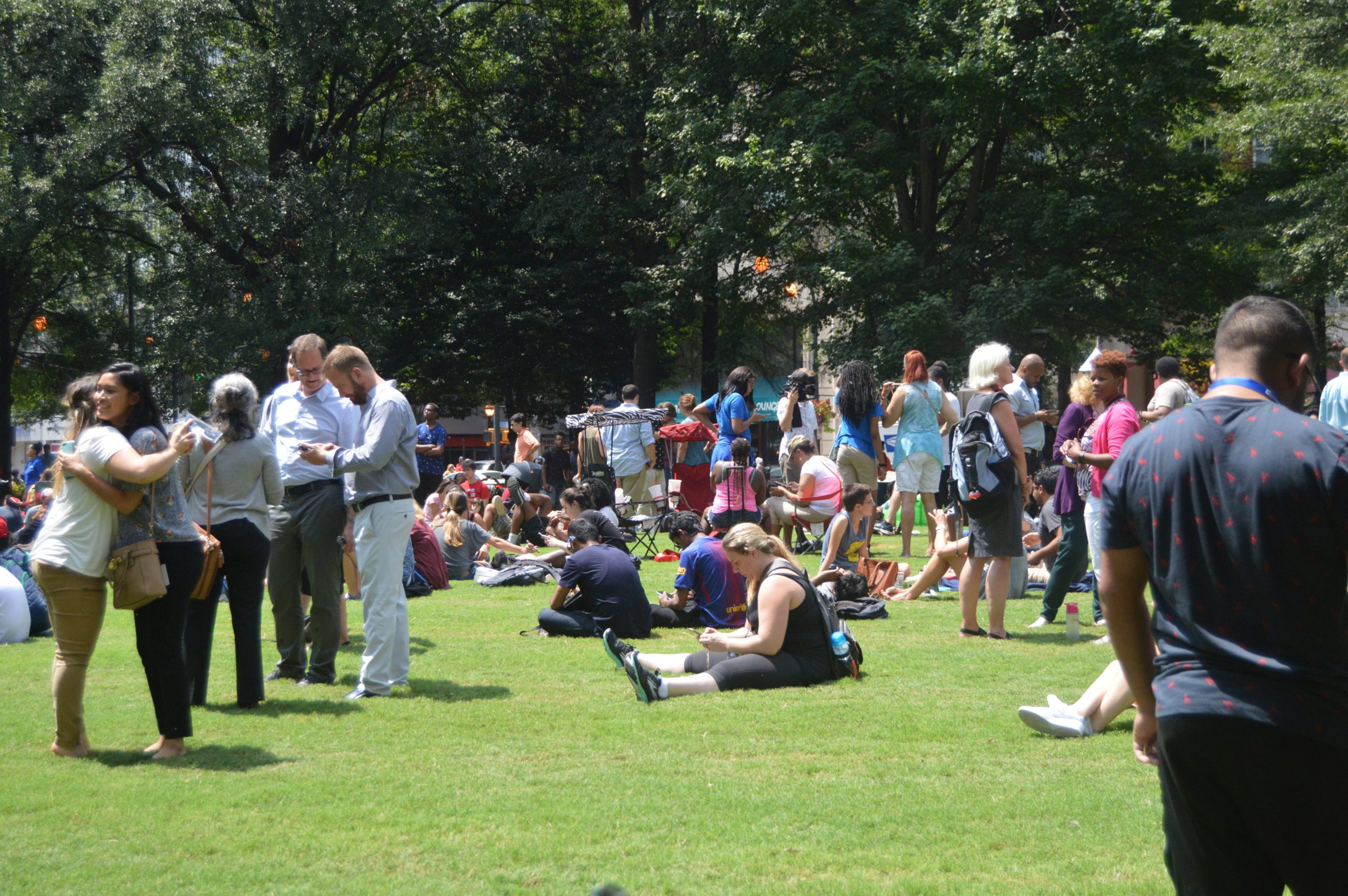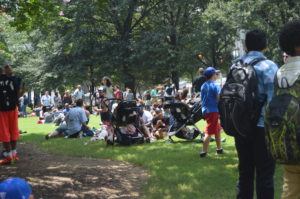

The Signal | Photo By: Syrina Merilan
On Aug. 21 the “Great American Eclipse” crossed over Georgia State’s Atlanta campus and hundreds of students and Atlanta citizens gathered to view the phenomenon at Woodruff park.
The eclipse’s narrow path of totality–the trajectory of the moon’s shadow that is cast over the earth during a solar eclipse–swept across the United States starting from Oregon to South Carolina, which is about 70 miles wide. Atlanta was one of 24 cities to observe the astronomical event.
While some cities saw the total solar eclipse, only 97 percent of the sun was obscured by the sun over Atlanta–a partial eclipse.
Total solar eclipses are visible from earth, on average, every 1.5 years. But the last time a coast-to-coast eclipse took place in the U.S. was in 1918.
A Scoop from an expert
Georgia State’s Department of Physics and Astronomy set up two telescopes at the Suntrust Building next to 25 Park Place to observe the astronomical levent; one specially filtered Coronado to directly view the sun and a Newtonian reflector to project an image on a screen for public viewing.
Professor of physics and astronomy Dr. John Wilson said the showcasing of the eclipse to the public was a great educational opportunity to participate in.
“This is real-live science, real-live astronomy,” Wilson said. “[There] can’t be any better education than that. This is the real deal.”
At 1:00 p.m. volunteers with the astronomy department started handing out 400 pairs of eclipse glasses to the giddy crowd, but the supply emptied quickly leaving many people to share.
The eclipse glasses block out the sun’s harsh light that, without the specialized lenses, would damage the viewer’s retinas. Totality, when the moon has completely covered the sun, is the only safe period to look up at the sun.
“You [should] never look at the sun,” Wilson said. “So we’re providing a safe way to do what you want to do.”
Georgia State students and Atlanta residents filled the front area of the Suntrust Building in anticipation of the eclipse, but on the second floor of 25 Park Place, a conference open to the public was being held where former chair of Georgia State’s Department of Physics and Astronomy Richard Miller educated a small group students and Atlanta residents about the basics of solar eclipses.
The conference had a live stream of the eclipse occurring over Rabun Gap-Nacoochee School in Dillard, Ga. Miller explained that a solar eclipse only occurs during a new moon where the moon aligns directly between the earth and the sun.
“You also don’t get a total eclipse unless the moon is at the point where it’s closest to the earth,” Miller said. “The apparent size of the moon is larger when it’s closest to the earth. When you have the moon directly in line with the sun and earth and at it’s closest approach to the earth, then there is a conical shadow cast by the moon back toward the earth.”
As the moon moves in its orbit the shadow being cast would also sweep across the area of the earth where it is directly aligned with the planet and the sun. The next solar eclipse over the U.S. is expected to occur in 2024.
Before the Eclipse
The 2017 Eclipse had students all over campus in a frenzy as it approached on Monday afternoon. One particular area that was crowded with students was in front of Langdale Hall.
Professors stood in front of the building giving student a chance to look through a telescope and capture what looking at the eclipse would be like. The line wrapped around the fountain as students stood to get their turn to get a peak. Glasses were given to students who arrived early so that could get a better look when the time came.
Georgia State student Eesa Chavis made an effort to find eclipse glasses to prevent eye damage to see the astrological event.
“I’m excited to see it. I think natural phenomenon are beautiful. I have to go find glasses so I can fully watch it. I don’t want to go blind,” Chavis said.
Many student had the fear of something happening to their eyesight, but were still wanting to attempt to take that risk.
“I’m not expecting to see it so close. It is really dope being out here. I’m trying not to look at it straight but I might take a quick glance,” Elijah Thelusma said.
A couple of the students excitement came from learning about the eclipse in classes that they have taken at Georgia State.
“I am actually really excited about the solar eclipse, We talked about eclipses in my astronomy class. I’m sad because I am going to be in class while it is happening! Hopefully I can see it online.” Kara Nelson said.
Eclipse leaves students with mixed reviews
The Georgia State students told The Signal both positive and negative reviews of the once in a lifetime event.
Akash Patel, a physics major at Georgia State in attendance for the eclipse said he was “excited” for the the event.
“This is my first time,” Patel said. “I think this one’s pretty rare too; in Atlanta, I think it was about 100 years ago.”
However, there were some of those who were not so impressed by the sight of the eclipse. Georgia State student Jordan Glaze said that the event was underwhelming.
“It was a cool event and all, but truth be told, I felt like it was over-hyped,” Glaze said.
Another student Ceyvion Morgan felt similarly, because her expectations of the event were not met.
“I was disappointed. I thought the sun would be completely blocked out and it would completely dark,” Morgan said.
Georgia State student Phillip Quinones said though the turnout for the event was great he wished the same amount of people would show for protests.
“It’s great that everyone came out and got to see this today, but seeing this many people come out for this is a little sad,” Quinones said. “I just wish people would get out for rallies and protest, like they did for the eclipse.”
